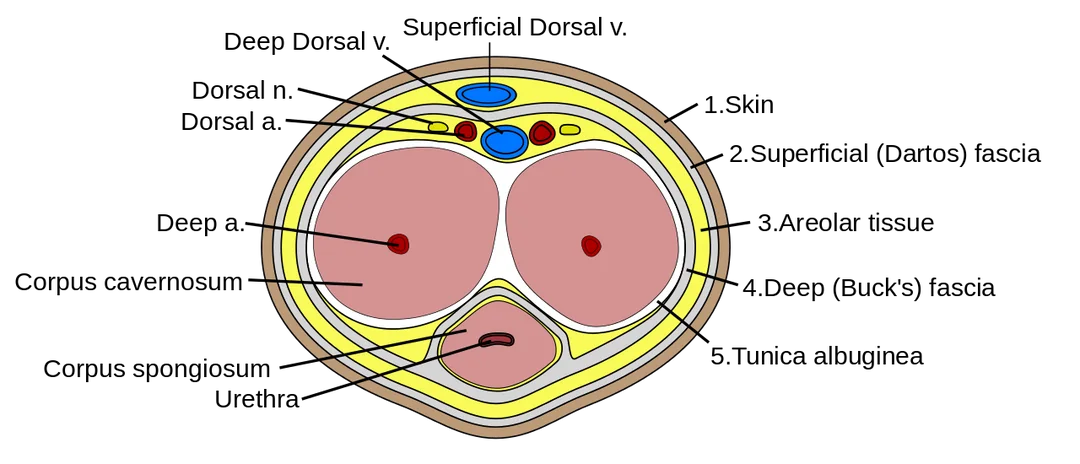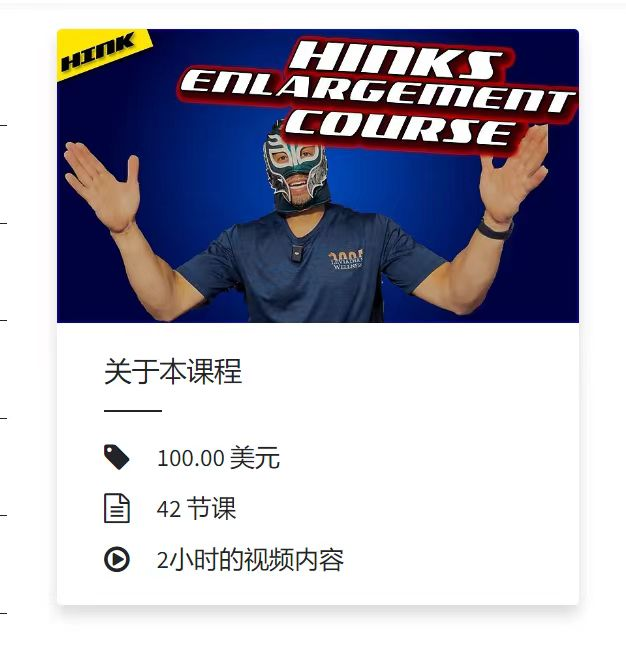reddit上的好文分享
How does PE actually work. Like, on a cellular level? What exactly is happening in the tunica albuginea, the suspensory ligament and the erectile tissue? Let’s deep-dive.
PE 实际上是如何运作的。比如,在细胞层面上?白膜、悬韧带和勃起组织到底发生了什么?让我们深入研究一下。
I will assume some prior knowledge of cell biology, but try to make this as simple as I can. I hate holding back on using proper language, however, so please excuse some scientific lingo. You might even learn a new word or two…
我将假设有一些细胞生物学的先验知识,但尽量使它变得简单。然而,我讨厌不使用适当的语言,所以请原谅一些科学术语。你甚至可能会学到一两个新单词……
![图片[1]-PE 实际上是如何运作的?有点深入的探讨。-藏精阁](https://netke01.top/wp-content/uploads/2024/09/how-does-pe-actually-work-a-somewhat-deep-dive-v0-porkmnrt76gc1-300x129.webp)
阴茎横截面
I assume you know that we are primarily enlarging the penis by stretching the suspensory ligaments, the tunica albuginea and to some extent also Buck’s fascia (which in addition to encapsulating the two corpora cavernosa (CC) and the tunica albuginea (TA) also constitutes the outer layer of the corpus spongiosum (CS), and transitions into the suspensory ligament, which is just a continuation of Buck’s fascia). We are also stimulating the production of more blood-holding tissue inside the CS and CC to “fill in the gains” and convert an increased flaccid length to actual increased erect length, as well as filling out any girth gains.
我假设你知道我们主要通过拉伸悬韧带、白膜和某种程度上的筋膜来扩大阴茎(除了封装两个海绵体 (CC) 和白膜 (TA) 还构成海绵体 (CS) 的外层,并过渡到悬韧带, 这只是筋膜的延续)。我们还刺激 CS 和 CC 内产生更多的血液持有组织,以“填充增益”并将增加的松弛长度转化为实际增加的勃起长度,以及填充任何周长增加。
But how? Mechanotransduction and growth factors!
但是怎么做呢?机械转导和生长因子!
What exactly goes on in the tunica or suspensory ligament when we stretch it. And why does stretching cause growth? Are we making it thinner, as when a rubber band gets thinner the more you stretch it? Or are we causing it to grow thicker, and if so how? That’s what I will attempt to explain.
当我们伸展外膜或悬韧带时,它究竟发生了什么。为什么拉伸会导致生长?我们是否让它变得更薄,就像橡皮筋拉得越紧越细一样?或者我们是否导致它变得更厚,如果是这样,它是如何的?这就是我将尝试解释的内容。
The “glue” that holds the various organs of our bodies together, which makes up the material between our muscles and our skin for instance, is called the “ECM” – the extracellular matrix”. In this, we have a lot of interstitial fluid, and many cells get their nutrients from this fluid and dump their waste products into it. The matrix itself is made almost entirely of sticky fibres of collagen – it’s like an open cell foam. This collagen is produced by fibroblasts – the same type of cell that produces the collagen in your fascia, tendons, ligaments, and most importantly for our purposes our tunica albuginea.
例如,将我们身体各个器官固定在一起的“胶水”,它构成了我们的肌肉和皮肤之间的材料,被称为“ECM”——细胞外基质”。在这个过程中,我们有很多间质液,许多细胞从这些液体中获取营养并将其废物倾倒到其中。基质本身几乎完全由胶原蛋白的粘性纤维制成 – 它就像一个开孔泡沫。这种胶原蛋白是由成纤维细胞产生的 – 与在筋膜、肌腱、韧带中产生胶原蛋白的细胞类型相同,最重要的是,我们的白膜。
Fibroblast (a type of “mesenchymal stromal cells”, which is a subcategory of stem cells), as most other cells, have a soft internal skeleton, and this skeleton sort of protrudes through the cell membrane at special adhesion sites, and this is where cells attach to other cells and stick together. Here’s a quote from a study which explains it pretty well, but buckle in for some lingo…
与大多数其他细胞一样,成纤维细胞(一种“间充质基质细胞”,是干细胞的一个子类别)具有柔软的内部骨架,这种骨架在特殊的粘附部位穿过细胞膜突出,这是细胞附着在其他细胞上并粘在一起的地方。“ 这是一项研究的引文,它解释得很好,但请系好安全带,了解一些行话……
“Cells can detect and react to the biophysical properties of the extracellular environment through integrin-based adhesion sites and adapt to the extracellular milieu in a process called mechanotransduction. At these adhesion sites, integrins connect the extracellular matrix (ECM) with the F-actin cytoskeleton and transduce mechanical forces generated by the actin retrograde flow and myosin II to the ECM through mechanosensitive focal adhesion proteins that are collectively termed the “molecular clutch.” The transmission of forces across integrin-based adhesions establishes a mechanical reciprocity between the viscoelasticity of the ECM and the cellular tension. During mechanotransduction, force allosterically alters the functions of mechanosensitive proteins within adhesions to elicit biochemical signals that regulate both rapid responses in cellular mechanics and long-term changes in gene expression. Integrin-mediated mechanotransduction plays important roles in development and tissue homeostasis, and its dysregulation is often associated with diseases.” From: Integrin-mediated mechanotransduction, Sun et al Journal of Cell Biology 2016.
“细胞可以通过基于整合素的粘附位点检测细胞外环境的生物物理特性并对其做出反应,并在称为机械转导的过程中适应细胞外环境。在这些粘附位点,整合素将细胞外基质 (ECM) 与 F-肌动蛋白细胞骨架连接起来,并通过统称为“分子离合器”的机械敏感黏着斑蛋白将肌动蛋白逆行流和肌球蛋白 II 产生的机械力转导到 ECM。力通过基于整合素的粘附传递在 ECM 的粘弹性和细胞张力之间建立了机械互易关系。在机械转导过程中,力变构地改变粘附内机械敏感蛋白的功能,以引发调节细胞力学快速反应和基因表达长期变化的生化信号。整合素介导的机械转导在发育和组织稳态中起重要作用,其失调通常与疾病有关。来自:整合素介导的机械转导,Sun 等人 细胞生物学杂志 2016。
Allow me to continue in technical fashion; Fibronectin is a high-molecular-weight glycoprotein of the ECM that fibroblasts produce. It’s involved in cell adhesion, growth, migration, and differentiation. Fibroblasts attach to fibronectin via integrins, which are transmembrane receptors that facilitate cell-ECM adhesion. This interaction not only anchors fibroblasts within the fascial tissue but also transmits mechanical signals between the ECM and the cytoskeleton of the fibroblasts, influencing cell behaviour and tissue remodelling. Fibroblasts also connect to each other directly through “gap junctions”, which are specialised intercellular connections that allow for the direct transfer of ions, metabolites, and other small molecules between cells. This communication modality is important for coordinating cellular activities across the tissue, including responses to mechanical stress and the regulation of tissue repair and regeneration.
请允许我继续以技术方式;纤连蛋白是成纤维细胞产生的 ECM 的高分子量糖蛋白。它参与细胞粘附、生长、迁移和分化。成纤维细胞通过整合素附着在纤连蛋白上,整合素是促进细胞-ECM 粘附的跨膜受体。这种相互作用不仅将成纤维细胞锚定在筋膜组织内,而且还在 ECM 和成纤维细胞的细胞骨架之间传递机械信号,影响细胞行为和组织重塑。成纤维细胞还通过“间隙连接”直接相互连接,“间隙连接”是专门的细胞间连接,允许离子、代谢物和其他小分子在细胞之间直接转移。这种通信方式对于协调整个组织的细胞活动非常重要,包括对机械应力的反应以及组织修复和再生的调节。
Now again, but simplified:
现在再来一次,但简化一下:
Ok, that was a lot of complicated lingo, but the main thing to take away is that certain cells are sensitive to mechanical forces such as stretching. They register these forces and activate cellular machinery to respond – both short-term responses and long-term responses. Fibroblasts in the tunica and ligament will up-regulate the production of collagen. They go: “Oops, that was a LOT of stretching my dude – in fact it was a little too much for comfort man – better make more collagen so that we can resist that kind of stretching in the future without taking damage in case you ever pull that hard again!” In biology and medicine, this is called “adaptation”. The exact same thing can be observed in blood vessels, where repeated stretching stimulus can cause the production of more collagen to thicken the outer layer and to increase the internal volume to increase blood carrying capacity.
好吧,这是很多复杂的术语,但主要要指出的是,某些细胞对拉伸等机械力很敏感。它们记录这些力量并激活细胞机制进行响应 – 包括短期响应和长期响应。外膜和韧带中的成纤维细胞会上调胶原蛋白的产生。他们说:“哎呀,我的家伙,这真是太伸展了——事实上,这对安慰者来说有点太多了——最好制造更多的胶原蛋白,这样我们就可以在未来抵抗这种拉伸,而不会受到伤害,以防你再次用力拉扯!在生物学和医学中,这被称为“适应”。在血管中可以观察到完全相同的事情,在那里反复拉伸刺激会导致产生更多的胶原蛋白,使外层变厚,并增加内部体积以增加血液携带能力。
This whole process of up-regulating gene expression for growth is controlled by external and internal chemical growth factors. There will be an amount of inflammation to help recruit the immune system for clean-up and repair. There will be some amount (probably small, but I don’t know this for sure) of hyperplasia, i.e. production of more fibroblasts, and there will probably be some amount of cell growth (hypertrophy) of the individual fibroblasts for them to cope with the increased demand for collagen production. But more than anything, there will be more collagen produced. The exact cellular pathways by which mechanical stress causes this cascade of events that results in the release of growth factors “is not well understood”, as scientific studies often say – but we do know the result.
上调基因表达以促进生长的整个过程由外部和内部化学生长因子控制。会有一定量的炎症来帮助招募免疫系统进行清理和修复。会有一定量(可能很小,但我不确定)的增生,即产生更多的成纤维细胞,并且可能会有一定量的单个成纤维细胞生长(肥大),以便它们应对对胶原蛋白产生的增加的需求。但最重要的是,会产生更多的胶原蛋白。正如科学研究经常说的那样,机械应力导致这种导致生长因子释放的级联事件的确切细胞途径“尚不清楚”——但我们确实知道结果。
Several growth factors are secreted by fibroblasts in response to mechanical stress, including:
成纤维细胞在机械应力下分泌几种生长因子,包括:
Transforming Growth Factor-beta (TGF-β), which is a key regulator of cell proliferation, differentiation, and ECM production. It plays a significant role in wound healing and fibrosis, promoting the deposition of collagen and other ECM proteins to strengthen the tissue. We don’t want fibrosis, which is just another name for scar tissue. If you pull so hard you get fibrosis, you’re on the path to developing Peyronies disease. But we do want some production of TGF-β for sure, which is what we get by pulling adequately hard but not too hard on our junk.
转化生长因子-β (TGF-β),它是细胞增殖、分化和 ECM 产生的关键调节因子。它在伤口愈合和纤维化中起着重要作用,促进胶原蛋白和其他 ECM 蛋白的沉积以加强组织。我们不要纤维化,纤维化只是疤痕组织的别称。如果你用力拉扯以至于纤维化,你就走上了患上佩罗尼氏病的道路。但我们确实希望生产一些 TGF-β,这就是我们通过足够用力但不要太用力地拉动我们的垃圾所得到的。
Fibroblast Growth Factors (FGFs), which are involved in a variety of processes, including cell growth, morphogenesis, and tissue repair. They can stimulate fibroblasts to proliferate and increase the synthesis of ECM components.
成纤维细胞生长因子 (FGF),参与多种过程,包括细胞生长、形态发生和组织修复。它们可以刺激成纤维细胞增殖并增加 ECM 成分的合成。
Platelet-Derived Growth Factor (PDGF), which attracts fibroblasts to the site of an injury and stimulates their proliferation. It also plays a role in vascular remodelling and can promote the synthesis of ECM components.
血小板衍生生长因子 (PDGF),将成纤维细胞吸引到损伤部位并刺激其增殖。它还在血管重塑中发挥作用,并可以促进 ECM 成分的合成。
Vascular Endothelial Growth Factor (VEGF), which is primarily known for its role in angiogenesis (the formation of new blood vessels), but can also affect fibroblasts by promoting the formation of new blood vessels needed to supply nutrients to repairing tissues.
血管内皮生长因子 (VEGF),主要以其在血管生成(新血管的形成)中的作用而闻名,但也可以通过促进新血管的形成来影响成纤维细胞,这些血管是提供修复组织所需的营养所必需的。
![图片[2]-PE 实际上是如何运作的?有点深入的探讨。-藏精阁](https://netke01.top/wp-content/uploads/2024/09/how-does-pe-actually-work-a-somewhat-deep-dive-v0-wyarx4c086gc1-192x300.webp)
![图片[3]-PE 实际上是如何运作的?有点深入的探讨。-藏精阁](https://netke01.top/wp-content/uploads/2024/09/how-does-pe-actually-work-a-somewhat-deep-dive-v0-zbdi8s5286gc1-260x300.webp)
So, your tunica albuginea will not grow thinner as you stretch it. Instead, it will actually grow thicker. It will in fact grow so thick it will gradually get harder and harder to gain since its load-bearing capacity will increase. In the end, you won’t be able to pull hard enough to cause good growth stimulus with a vacuum cup, because that kind of pulling force would result in blisters. This is why it’s a good idea to take a hiatus now and then – a deconditioning break to let your tunica rest completely, where it gets a chance to grow thinner and more malleable again. This is also where people have experimented with chemical compounds to break down the collagen. It’s also where heat can be tremendously useful to soften the collagen and allow you to stretch your penis more than you would otherwise be able to.
因此,您的 Tunica albuginea 不会随着您的拉伸而变薄。相反,它实际上会变得更厚。事实上,它会变得如此厚实,因为它的承载能力会增加,因此会逐渐变得越来越难获得。最后,您将无法用真空吸盘用力拉动以刺激生长,因为这种拉力会导致水泡。这就是为什么偶尔休息是个好主意 – 一个去适应的休息,让你的外膜完全休息,在那里它有机会再次变得更薄、更具延展性。这也是人们尝试使用化合物来分解胶原蛋白的地方。这也是热量可以极大地软化胶原蛋白并让您比平时更多地伸展阴茎的地方。
Heat and collagen malleability
热量和胶原蛋白延展性
So, maybe let’s talk about heat for a while. Heat changes the properties of collagen. The penis is normally around 33-34°C, and at that temperature collagen is pretty stiff because individual strands of collagen called “fibrils” attach to nearby fibrils with hydrogen bonds. Pulling on collagenous tissue repeatedly in a consistent direction will cause hydrogen bonds to break and the individual fibrils to align in the direction of the force, where they are strongest. Heat helps break these bonds and makes stretching the tissue easier at lower weights. Instead of pulling with 10 lbs of force to achieve a certain elongation/distension, you might get away with using half as much for the same result. But you need to get it up to around 39-43°C, which can basically only be done with infrared heat or ultrasonic vibrations. Normal heat pads or warm rice socks would need to be unbearably hot to the skin for there to be any chance that your tunica gets to ~40°C. Many IR heat pads with visible IR diodes also have red light diodes, and 640 nm red light has been shown to increase collagen production in skin. It’s unclear whether it can reach all the way inside the penis to the tunica albuginea, but it’s quite possible that it can. If it does, this would be an added bonus. I urge anyone to read the thread “Hanging with FIRe” on Thunder’s Place if you’re interested in how all of this heat+collagen business works.
那么,也许让我们先谈谈热量。热量会改变胶原蛋白的特性。阴茎通常在 33-34°C 左右,在这个温度下,胶原蛋白非常坚硬,因为称为“原纤维”的单条胶原蛋白通过氢键附着在附近的原纤维上。沿一致方向反复拉动胶原组织将导致氢键断裂,并且单个原纤维沿力最强的方向对齐。热量有助于打破这些键,并使在较轻的重量下更容易拉伸组织。与其用 10 磅的力拉动以达到一定的伸长/膨胀,不如使用一半的力来获得相同的结果。但你需要把它提高到 39-43°C 左右,这基本上只能通过红外热或超声波振动来完成。普通的加热垫或温暖的米袜需要对皮肤热得难以忍受,您的外膜才有可能达到 ~40°C。 许多带有可见红外二极管的红外热垫也具有红光二极管,640 nm 红光已被证明可以增加皮肤中胶原蛋白的产生。目前尚不清楚它是否能一直到达阴茎内部到白膜,但很有可能可以。如果是这样,这将是一个额外的好处。如果您对所有这些 heat+collagen 业务的运作方式感兴趣,我敦促任何人阅读 Thunder’s Place 上的“Hanging with FIRe”帖子。
Growing erectile tissue – filling the sausage skin
生长的勃起组织 – 填充香肠皮
But let’s get back to growth signals again. The suspensory ligament and tunica albuginea, as well as the Buck’s fascia are all collagenous tissue. We now have a grasp of what causes them to grow. But a consistent experience in PE is that we will pull on our weeners for months on end without seeing much at all in terms of erect growth – all we see is a longer stretched flaccid. BPEL tends to lag behind BPSFL by 3-6 months at least.
但让我们再次回到增长信号。悬韧带和白膜,以及巴克筋膜都是胶原组织。我们现在掌握了导致它们增长的原因。但是,在 PE 中,一个一致的经验是,我们会连续几个月拉动我们的 Weeners,而根本看不到太多的勃起生长——我们看到的只是更长的拉伸松弛。BPEL 往往至少比 BPSFL 滞后 3-6 个月。
This is where PervMcSwerve’s “sausage analogy” is apt: By pulling on (or inflating) your sausage you stretch the sausage skin, lengthwise or girthwise, but you don’t add any filling to it, so it won’t look bigger. You need to add more stuffing inside the sausage skin. The stuffing in this case is erectile tissue, which is vascular/endothelial in nature.
这就是 PervMcSwerve 的“香肠类比”恰当的地方:通过拉动(或充气)香肠,你可以纵向或周长拉伸香肠皮,但你没有添加任何馅料,所以它不会看起来更大。你需要在香肠皮里面添加更多的馅料。在这种情况下,填充物是勃起组织,它本质上是血管/内皮的。
In order to grow more erectile tissue, we need to cause a significant release of the vascular endothelial growth factor (VEGF) I mentioned earlier. And here’s the thing: We know exactly how to do this! VEGF is released my many tissues in our body in response to hypoxia, which is a fancy word for lack of oxygen. VEGF is like a chemical signal that tells any vascular or endothelial tissue to start proliferating and growing. So how do we cause hypoxia inside the penis? Simple – just clamp it hard and let the clamp stay on for ten minutes. This will cause the blood trapped inside the penis to be depleted of oxygen, and carbon dioxide will increase, changing the pH. In response, VEGF is released by smooth muscle cells in the CC and CS as well as by fibroblasts and the endothelial cells in the small blood vessels, and the result is the growth of more blood holding tissue. You fill out your sausage. Your Vienna sausage becomes a Kielbasa and eventually, hopefully, a Falu sausage (see Swedish classic porn flick “Fäbodjäntan” for the pop culture reference).
为了生长更多的勃起组织,我们需要引起我之前提到的血管内皮生长因子 (VEGF) 的显着释放。事情是这样的:我们确切地知道如何做到这一点!VEGF 是我们体内许多组织因缺氧而释放的,缺氧是缺氧的花哨词。VEGF 就像一个化学信号,告诉任何血管或内皮组织开始增殖和生长。那么我们如何导致阴茎内部缺氧呢?简单 – 只需用力夹住它,然后让夹子保持十分钟。这将导致阴茎内的血液缺氧,二氧化碳会增加,从而改变 pH 值。作为响应,VEGF 由 CC 和 CS 中的平滑肌细胞以及小血管中的成纤维细胞和内皮细胞释放,结果是生长出更多的血液保持组织。你填满你的香肠。你的维也纳香肠变成了 Kielbasa,最终,希望能变成 Falu 香肠(有关流行文化的参考,请参阅瑞典经典色情电影“Fäbodjäntan”)。
—–
The alternate hypothesis – micro tears.
另一种假设 – 微撕裂。
Are these the only ways your pickle grows? What about micro-tears and healing? Well, all I can say is that we don’t really have a full understanding of the process. It might be that this old PE theory holds a grain of truth, but I don’t think the evidence is there. It would be super interesting to see some kind of detailed imaging study of PE. Perhaps MRI, CT or high-resolution ultrasound, perhaps performed in a vacuum pump under pressure, to see whether the “micro-tears” hypothesis holds up to scrutiny. I doubt it does.
这些是你的泡菜生长的唯一方式吗?微撕裂和愈合呢?好吧,我只能说,我们并没有真正完全了解这个过程。也许这个古老的 PE 理论有一定的道理,但我认为没有证据。看到 PE 的某种详细影像学研究会非常有趣。也许是 MRI、CT 或高分辨率超声,也许是在压力下在真空泵中进行的,以查看“微撕裂”假说是否经得起推敲。我怀疑它确实如此。
____
What about fatigue and strain?
疲劳和劳损呢?
Well, when you pull on a tendon with a “small” amount of force, it will spring right back when you release it, and be exactly as long after as before. If you pull on it a little harder, with “medium” force, and repeat this pull many times and let it go on for a certain time, it will not fully spring back to its previous length, but will stay elongated for a while. You will have “remodelled” it. If you pull on it with even greater force, you get into the danger zone where small tears will start to form – individual collagen fibres will rip. This will cause swelling and require a time to heal, and it will weaken the tendon’s load bearing capacity – i.e. you have sprained it. If you pull with even greater force, it will rip completely.
好吧,当你用“小”的力拉动肌腱时,当你松开它时,它会立即弹回,并且和以前一样长。如果你用“中等”力稍微用力拉动它,然后重复多次拉动并让它持续一段时间,它不会完全弹回原来的长度,而是会保持拉长一段时间。您将“改造”它。如果你用更大的力拉它,你会进入危险区域,在那里会开始形成小撕裂 – 单个胶原纤维会撕裂。这会导致肿胀并需要一段时间才能愈合,并且会削弱肌腱的承重能力 – 即你扭伤了它。如果你用更大的力拉动,它会完全撕裂。
With PE, best practice is to avoid tearing your suspensory ligament and tunica albuginea. You also don’t want to be in the “toe region” of the tension/deformation graph. You want your tunica to be about 3% stretched/engorged after a session as compared to its prior length/girth (this is called “fatigue” in BD’s terminology), and to accomplish this you need to be at about 4-6% or perhaps a little more, while you’re in the device you’re using (called “strain”).
对于 PE,最佳做法是避免撕裂悬韧带和白膜。您也不想位于张力/变形图的“脚趾区域”。与之前的长度/周长相比,您希望您的外膜在训练后拉伸/充血约 3%(这在 BD 的术语中称为“疲劳”),要做到这一点,您需要在您使用的设备中时达到大约 4-6% 或更多一点(称为“拉伤”)。
Then you can just hope that a small amount of this elongation becomes “locked in” and becomes permanent. I personally believe it’s not strictly necessary to achieve this target elongation/expansion in every session, but that you do need to achieve it frequently in order to see good growth. The matter is complicated by the fact that there are smooth muscle cells inside the tunica albuginea and that there is a connection to your nervous system. You need to be in a relaxed state for the tunica to elongate/distend well and not turtle too much after your session.
然后你可以希望这种伸长的一小部分被 “锁定 ”并成为永久性的。我个人认为,并非绝对必要在每次会话中都实现这个目标的延伸/扩展,但您确实需要经常实现它才能看到良好的增长。由于白膜内部有平滑肌细胞并且与您的神经系统有联系,因此问题变得复杂。您需要处于放松的状态,以便 Tunica 很好地伸长/膨胀,并且在治疗后不要过多地龟缩。
____
Penile nutrition for growth?
营养促进生长?
The fibroblasts in the tunica albuginea don’t have direct access to a blood supply. Instead they get nutrients only from the interstitial fluid in the areolar tissue outside it, and by diffusion from the corpora cavernosa. In order to produce collagen, they need good nutrient delivery, which you can accomplish by being erect often and by increasing flaccid blood flow. This is where taking a PDE-5 inhibitor (phosphodiesterase type 5) like Cialis or Viagra and/or L-Citrulline can help by helping with vasodilation through relaxation of smooth muscle cells in the vasculature of the CC. More blood flow = more better. If you eat enough proteins, there is no reason to further supplement with collagen or glycine, proline and lysine for that matter – you will only ever grow by fractions of grams per day, after all. The problem isn’t your nutrient status, but the speed of nutrient delivery – so focus on having good nocturnal erections and plenty of daytime erections as well, if you want to optimise matters. Citrulline and/or Cialis are your best friends in this respect. And being a horny goat, of course! 🙂
白膜中的成纤维细胞不能直接获得血液供应。相反,它们仅从乳晕外乳晕组织中的间质液中获取营养,并通过海绵体的扩散获得营养。为了产生胶原蛋白,它们需要良好的营养输送,您可以通过经常勃起和增加松弛的血流量来实现。这就是服用 PDE-5 抑制剂(磷酸二酯酶 5 型),如 Cialis 或伟哥和/或 L-瓜氨酸,可以通过松弛 CC 脉管系统中的平滑肌细胞来帮助血管舒张。更多的血流量 = 更好。如果你吃了足够的蛋白质,就没有理由进一步补充胶原蛋白或甘氨酸、脯氨酸和赖氨酸——毕竟,你每天只会增长几分之一克。问题不在于你的营养状况,而在于营养输送的速度 – 所以如果你想优化问题,就要专注于良好的夜间勃起和大量的白天勃起。瓜氨酸和/或希爱力是你在这方面最好的朋友。当然,还要成为一只好色的山羊!:)
——
But what is a greater understanding of these processes good for?
但是,更深入地了解这些过程有什么好处呢?
That’s a good question. One thing it’s useful for, is that it can help us generate further hypotheses or guide us in the search for even deeper and more instrumentally useful knowledge. For instance, knowing about mechanotransduction, integrins and growth factors can help us ask questions about what kind of stimulus causes the best growth trigger. Is it extended periods of hard stretching, or repeated sharp tugs, or repeated slower tugs that trigger growth the most? In other words, are super short intervals of super high tension beneficial? Are minutes-long intervals better than seconds long? Are 2-minute intervals better than sets of 10+ minutes?
这是个好问题。它有用的一点是,它可以帮助我们产生进一步的假设或指导我们寻找更深入、更有用的知识。例如,了解机械转导、整合素和生长因子可以帮助我们提出关于什么样的刺激会导致最佳生长触发因素的问题。是长时间的用力拉伸,还是反复的剧烈拉扯,还是反复的较慢的拉扯,最能触发生长?换句话说,超高张力的超短间隔有益吗?分钟长的间隔是否比秒长的间隔更好?2 分钟的间隔是否比 10+ 分钟的一组更好?
Well, the strength we pull or inflate with matters. So does the number of times we stretch. So does the total time we stretch. All of them are growth triggers. Each will have their own unique trade-offs. Pulling too hard is dangerous. Pulling for a long time causes your sessions to go on for a long time, and if you’re not using enough force that time is completely wasted (as with some low-tension all day stretchers). Interval pumping/stretching is very active, so unless you have an automatic pump with intervals capability you’ll be busy the whole time. As long as you use adequate force, both intervals and constant tension/pressure will work, but a combination of the two might be the best of both worlds.
好吧,我们拉动或膨胀的力量很重要。我们伸展的次数也是如此。我们伸展的总时间也是如此。所有这些都是增长的触发因素。每个都将有自己独特的权衡。拉得太用力是危险的。长时间拉扯会导致您的训练持续很长时间,如果您没有使用足够的力,那时间就完全浪费了(就像一些低张力的全天担架一样)。间歇吸乳/伸展非常活跃,因此除非您有具有间歇功能的自动吸乳器,否则您将一直很忙。只要你使用足够的力,间隔和恒定张力/压力都可以,但两者的结合可能是两全其美的。
Another question to ask might be whether it’s beneficial to pull in multiple directions during a single session. Does triggering stretch receptors on multiple axes cause a better growth signal than only using longitudinal or transverse force? Well, I think we can say with some confidence that we simply don’t know that (yet). Doing bundled stretches before pumping gives me better expansion than not doing them – but is it also causing a better release of the four growth factors?
要问的另一个问题可能是在单个会话期间向多个方向拉动是否有好处。在多个轴上触发拉伸受体是否比仅使用纵向或横向力产生更好的生长信号?嗯,我认为我们可以自信地说,我们只是(还)不知道这一点。在吸乳前进行捆绑式拉伸比不做伸展运动能更好地扩张 – 但它是否也会导致四种生长因子的更好释放?
Does it matter whether I go to 4% expansion or 8% after pumping? Are two 10-minute sets of clamping better than a single 10-minute set for hypoxia? Can I do hypoxia clamping 7 days per week as long as I stay at 10 minutes per set, or will this cause issues? These are empirical questions and we only have n=1 “studies” with inconsistent methodology and no control groups to go by. Bro-science, in other words.
吸乳后我是膨胀 4% 还是 8% 重要吗?两组 10 分钟的钳夹是否比一组 10 分钟的缺氧更好?我可以每周 7 天进行缺氧钳夹,只要我每组保持 10 分钟,还是这会导致问题?这些是实证问题,我们只有 n=1 项方法不一致的“研究”,也没有对照组可供参考。换句话说,兄弟科学。


















- 最新
- 最热
只看作者